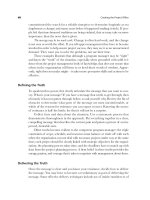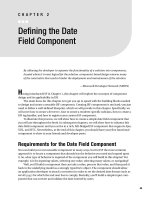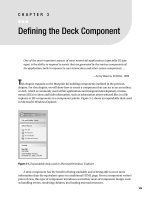Defining the project
Bạn đang xem bản rút gọn của tài liệu. Xem và tải ngay bản đầy đủ của tài liệu tại đây (134.19 KB, 14 trang )
4
Defining the project
Once the scope of the project has become clear and there is a commitment to
go ahead, it is necessary to define the project as a written document. This
might be called ‘terms of reference’, ‘project definition document’ or ‘project
brief’. The purpose of the project brief (or similar document) is to detail
exactly what the project is intended to produce and the resources and con-
straints within which it must be achieved. This document is almost always
signed by the sponsor of the project – the person who is funding the project
or who holds responsibility for the use of resources to achieve the outcomes
identified. The process of drawing up the brief can help to clarify anything
that had not previously been fully discussed, and often demonstrates that
there is more work to do before the brief can be completed.
WORKING WITH THE SPONSOR
The sponsor is the person or client or group who have commissioned the
project and put you in charge of managing it. In most workplace projects
there are costs of staff time and resources that must be funded. The sponsor
is the person who has ultimate responsibility for the funding and who will
say whether the project has or has not been successful in meeting its goals.
There may occasionally be projects where the work is contracted, com-
pleted and handed over with little communication, but in most projects it is
essential for the project manager to communicate with the sponsor or client.
Field and Keller (1998) propose a number of reasons why liaison is essential:
࿖
to establish mutual confidence and a cooperative climate;
࿖
to exchange technical information;
࿖
to report progress to the client;
࿖
to control changes while ensuring that the product matches the client’s
requirements as closely as is practical within time and budget constraints;
࿖
to make joint preparations for acceptance testing (to ensure that the client
can use the project outcomes as planned);
࿖
to prepare for transition to normal operation.
Communication of essential information and reporting of progress will often
require quite formal approaches, but many of the other reasons for liaison
can only be achieved through good informal communications and interper-
sonal relationships.
As the sponsor has such an important role you should ensure that you have
completely understood what he or she is expecting the project to achieve.
This is not always easy. It is worth checking out your understanding in sev-
eral different ways so that you are fully informed before you set off into
detailed planning. For example, you might ask the sponsor to tell you what
he or she would consider an outstandingly good outcome, and how this
would differ from a barely acceptable outcome. If you plan to achieve the
objectives that you think are appropriate, and you discover at a later date that
your project sponsor had different ideas and was imagining different out-
comes, it will usually be very difficult to bring the differences to a satisfactory
resolution.
Even when you have agreed the broad goals and the detailed objectives of
a project with your sponsor, you might find that events at a later date cause
you to revisit this agreement. This is why it is so important to have a written
agreement as a basis for the project planning. The agreement, the project
brief, is your licence to act on behalf of the sponsor. If you deviate from that
agreement without consulting the sponsor and seeking an amendment
to the agreement, you are in breach of the contract made. This may sound
very formal, but the project brief details the contract made between you and
the sponsor. The sponsor has to be accountable for his or her use of the
organization’s resources and has, in essence, delegated some of that
responsibility to you. The project brief details the extent of this delegated
46
Managing projects in human resources
responsibility, and you are accountable to the sponsor for the use of resources
to achieve the goals agreed.
It is very unlikely that you will be able to complete the project without
making any changes to the project brief, because it is impossible to foresee
everything that may impinge on the project as it is implemented. The impor-
tant thing is to keep working with the sponsor as you become aware of any
potential changes so that you can decide together how to respond and
whether to change the project brief. If you do decide to change the brief, it is
important to document the nature of the change and to obtain the sponsor’s
signature to demonstrate that the change has been agreed and authorized.
This ensures that if there is any dispute about whether the project has
achieved its aims, there will be a document that details exactly what was
agreed, against which the outcomes can be assessed.
You will probably have realized that it is helpful to keep in regular contact
with your sponsor so that there are no surprises as the project develops. In
some cases, the sponsor may prefer you to work closely with someone he or
she appoints to monitor the project, and you should then treat them as you
would the sponsor.
If you are carrying out a project that is essentially your own idea, and
something that you want to do and have the means to carry out without
drawing on additional resources, you may feel that your project does not
have a sponsor. It is worth considering whether you could ask someone to
act in that capacity anyway, so that you have a ‘sounding board’ to discuss
the project with. Even if all the aspects of the project fall within your own
areas of responsibility, you are still committing the organization’s resources
if you are spending your own work time on the project. If you can gain the
support of a more senior manager to act as the project sponsor, it will ensure
that you have the approval of your organization to carry out the project. It
might also be more beneficial to the organization if your project helps others
to consider alternative ways of achieving objectives and you might find that
your idea becomes a pilot project for eventual wider use.
WILL THE PROJECT BE SUPPORTED?
It is important to consider a wide range of views before starting any detailed
planning, whether the project is small or large. It is helpful to consult all the
people who might be affected by the project, the people who hold a stake in
the process or outcomes – the stakeholders. Stakeholders include the sponsor
or client of the project, anyone whose resources will be needed to carry out
the project, anyone who will contribute their work, time or energy to the
project and anyone who will be affected by the process or outcomes. This is
Defining the project
47
often a large number of people, and you might want to consider how to hear
representative views from groups of stakeholders.
Example 4.1
Issues identified in developing a project brief
A large broadcasting corporation had recently restructured and cre-
ated 15 programme director posts. After several months the organi-
zation’s perception was that these new programme directors were
struggling to implement the managerial element of their role. The so-
lution seemed simple, to design a management development pro-
gramme to improve and develop the managerial knowledge and skills
of programme directors. However, before this action was taken the
organizational development manager decided to interview some of
the new programme directors about their needs. They asked for de-
velopment around the following areas:
࿖
conflict management;
࿖
performance management;
࿖
budgetary management;
࿖
time management.
These areas could have been anticipated, but a number of other issues
were also identified. These included:
࿖
role clarification;
࿖
understanding of the new organization;
࿖
relationship building and networking;
࿖
an understanding of the wider world, the government’s agenda and
how to respond effectively to targets and demands.
These issues, which are quite basic (such as, ‘What exactly does my
role as programme director entail?’), were of real concern to the indi-
viduals involved. This enabled a programme of development to be
designed which was targeted at improving these skills and knowl-
edge areas identified by the programme directors, rather than making
assumptions and providing something less relevant.
(Adapted from a case study by Stephen Oliver, Management Train-
ing Consultant, Business Development Consultancy.)
48
Managing projects in human resources
People are sometimes reluctant to seek opinions from stakeholders who
might disapprove of the project. We might sometimes think that it is better
not to encourage discussion of controversial issues until the project is more
advanced. We sometimes do not even realize that there might be opposition
to an idea that seems a good one from our own perspective. It is worth con-
sidering the consequences of not understanding the opposition to a project.
Much of the concern about a project can be anticipated and avoided if the
views of stakeholders are understood at an early stage.
STAKEHOLDER MAPPING
You need to identify who your stakeholders are before you can consider the
impact that they might have on the project. Stakeholders will include:
࿖
The sponsor or client – the person or people who have commissioned or
authorized the project and who will provide resources. This person will
also usually be the one who confirms that the project has been successfully
completed.
࿖
The project team – these are the people who will carry out all of the tasks
and activities to complete the project. These people will need to have the
knowledge, skills and experience to achieve the goals of the project. They
also need to be available to work on the project at the right time.
࿖
Other managers in the organization – particularly line managers of peo-
ple who have been seconded to the project team and functional managers
who control resources that will be needed. You will often have to negotiate
with these people to ensure that your project team and other resources
are available at the right time.
࿖
Individuals and groups who will be affected by the project. These include
people who are interested in the process of the project (for example, peo-
ple whose lives may be disrupted as project tasks are carried out) and
people who may gain advantages or be disadvantaged by the outcomes
of the project. Customers and clients might be considered as a stakeholder
group.
࿖
Individuals and groups who hold direct influence over the project. It is
important to identify anyone or any group who holds the power to dam-
age or stop the project. These are powerful stakeholders whose particular
concerns may lead them to use their power to help or hinder the project.
Ask the question, ‘Who could stop this project?’ For example, who could
withhold funding or prevent access to labour or resources?
Defining the project
49









